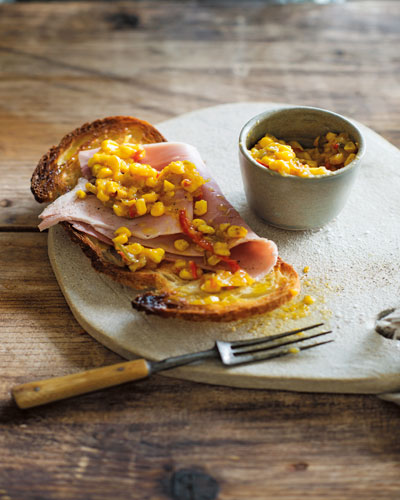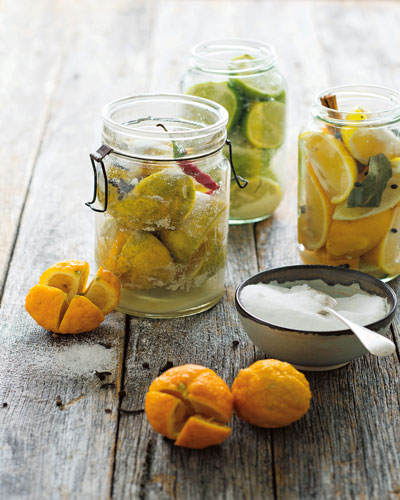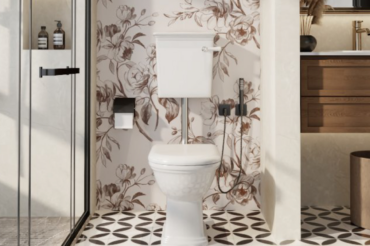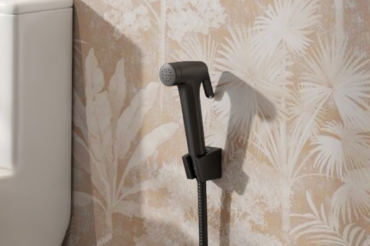
Bread & Butter Cucumber Pickles
Preparation time 20 minutes, plus 1–2 hours salting.
Cooking time about 15 minutes, plus 10 minutes heat processing.
Storage 6–12 months.
Makes about 6 x 375ml jars.
These are our signature pickles, the first ones we ever made, and now our bestsellers. They’re a great way to start your pickling adventures. Small cucumbers are best for pickling, as their water content is lower. Look out for bargain boxes of seconds at farmers’ markets — often the only difference is that they’re not straight! Feel free to experiment with spices. These are classic pickle spices, but you could use whole chillies, garlic cloves, bay leaves and strips of lemon zest.
2 kg Lebanese cucumbers (the smaller, the better)
2 tablespoons salt
1L white wine vinegar
220g caster sugar
½ teaspoon ground turmeric
2 small brown onions, thinly sliced
3 teaspoons brown mustard seeds
2 teaspoons fennel seeds
2 teaspoons dill seeds
2 teaspoons chilli flakes (optional)
12–18 black peppercorns
Slice the cucumbers into rounds about the thickness of a coin. Place them into a bowl and sprinkle with salt, then leave to sit for an hour or two (or overnight). This is to draw out any excess liquid; the bigger the cucumbers, the longer it will take. Transfer to a large colander and leave to drain thoroughly. Meanwhile, sterilise your jars. Make a brine by putting the vinegar, sugar, turmeric and 500ml of water into a medium non-reactive saucepan over low heat. Stir to dissolve the sugar, then increase the heat and bring to the boil. Let it bubble for 2–3 minutes, then remove from the heat.
Transfer the cucumbers to a large bowl. Add the onions, along with the mustard, fennel and dill seeds, as well as chilli flakes, if using. Use your hands to mix everything together well. When the jars are cool enough to handle, use small tongs or clean hands to carefully pack the cucumbers into the jars, adding 2 or 3 peppercorns to each jar. The jars should be full but not overpacked — the brine needs to cover every slice of cucumber, and if they are packed too tightly,the brine won’t be able to get into every nook and cranny.
Carefully fill the jars with the hot brine until the cucumbers are completely covered. Remove any air bubbles by gently tapping each jar on the work surface and sliding a butter knife or chopstick around the inside to release any hidden air pockets. You may need to add more brine or cucumbers after doing this (the liquid should reach about 1-1.2cm from the top of the jar). Wipe the rims of the jars with a clean cloth or paper towel and seal. Heat process for 10 minutes, then store in a cool, dark place. Although these pickles will keep for up to 12 months, they start to lose their crunch after about 6 months.
 Corn Salsa
Corn Salsa
Preparation time 15 minutes.
Cooking time 30 minutes, plus 10 minutes heat processing (optional).
Storage 1 month, or up to 12 months if heat processed.
Makes about 4 x 300ml jars.
The corn season spans the end of summer and the start of autumn, and we often bottle this towards the end of the season. It complements any Mexican-style meal, but is also good with scrambled, poached or fried eggs, or on a chicken or ham sandwich. Try mixing some corn salsa through a bread dough for a simple corn bread, or stir a couple of spoonfuls into a firm pancake batter to make quick corn fritters.
1½ tablespoons vegetable oil
1 large onion, finely chopped
1 tablespoon salt
2 small red capsicums, diced
5 small corn cobs, kernels cut from cobs
½ teaspoon ground coriander
¼ teaspoon ground celery seed
Pinch of cayenne
5 green chillies, sliced
Fi nely grated zest and juice of ½ lime
2 50ml white wine vinegar
2 tablespoons cornflour
¼ teaspoon ground turmeric
1 ½ tablespoons caster sugar
Heat the vegetable oil in a large saucepan over medium heat and sauté the onion with the salt until soft. Add the capsicum and sauté for a few minutes until starting to soften, then add the corn and sauté for another minute. Mix in the coriander, celery seed and cayenne, then take off the heat and stir through the green chillies, lime zest and juice.
For the salsa base, combine the vinegar with 250ml of water in a non-reactive saucepan. Put the cornflour and turmeric into a heatproof bowl, then stir in 2–3 tablespoons of the vinegar mixture to make a smooth paste. Add the sugar to the vinegar mixture, then place over medium heat and stir until the sugar has dissolved. When the mixture reaches simmering point, transfer it to a jug, then slowly pour it into the cornflour paste,whisking as you go until you have a smooth, thick sauce. Leave to cool. Pour the cooled salsa base over the vegetables and stir to coat evenly. The salsa can be served straightaway or kept in the fridge for up to a month.
If you want to bottle the salsa to store for use later in the year, or to give as a gift, pack it into sterilised jars and heat process for 10 minutes. Unopened jars can be stored in a cool, dark place for up to 12 months. Once opened, refrigerate and use within a couple of months.

Preserved Lemons or Limes
Preparation time 20 minutes.
Storage several years.
Makes 2 x 500ml jars.
Every home cook should know how to make preserved lemons or limes — they’re the most straightforward and cheapest of all the preserves. All you need is lemons or limes and salt. Once you have a jar of these on the go, you’ll wonder how you lived without them: use to pep up a white bean mash, stir through aioli, or smash into avocado and serve on toast.
1 kg lemons or limes (if using limes, you may need a few extra if they aren’t particularly juicy)
100–150g salt
For each jar of preserved lemons (optional):
1 bay leaf or 1 cinnamon stick
and 2 cloves
1 allspice berry
5 black peppercorns
For each jar of preserved limes (optional):
1 red chilli
½ teaspoon coriander
seeds
5 black peppercorns
First, sterilise your jars then leave to cool completely. Cut the lemons or limes into quarters or halves if very small. Place a tablespoon of salt into the bottom of each jar. Put a few layers of lemon or lime quarters into the jar, pressing down as you go to release the fruit’s juices. Slide your chosen spices down the side of each jar. Sprinkle over another layer of salt, then add another layer of lemon or lime quarters and repeat these layers until the jar is full. Remember to keep pushing down as you go. The fruit needs to be completely covered in salty juice — if your fruit hasn’t released enough of its own juices, squeeze a few extra and pour in this juice to cover. Leave 1cm of space between the top of the fruit and the lid of the jar — you don’t want the salty fruit touching the lid or it will corrode the metal. Seal the jars and let them sit in a cool, dark place for 6 weeks. Your lemons or limes are preserved when the salt has completely dissolved into a gel-like liquid. They will keep for years, but opened jars are best stored in the fridge (if the top layer of fruit looks discoloured, just discard it and the rest should be fine to use).









